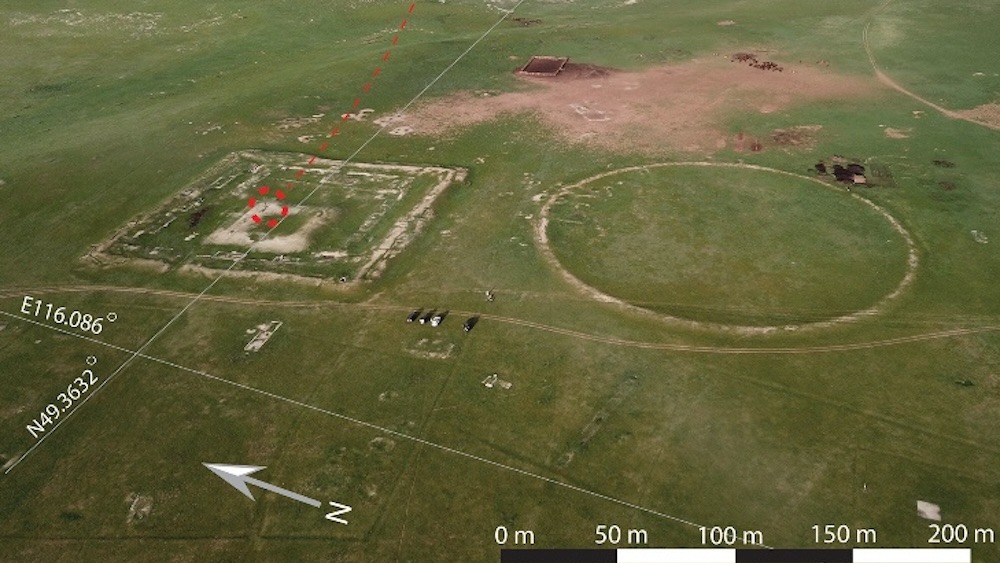1,000-year-old remains of 'elite woman' in silk cloak found in abandoned fortress in Mongolia
The burial site was hidden inside an abandoned fortress in Mongolia and contained the remains of a prestigious woman.

An "elite grave" discovered in the remnants of an abandoned fortress in Mongolia contains the remains of a woman dressed in a yellow, silk cloak and offers insight into the inner workings of burial and trade practices in an empire that flourished 1,000 years ago.
Archaeologists found the burial accidentally while surveying a site in northeastern Mongolia. The fortress, known as Khar Nuur, was built sometime between the 10th and 12th centuries, during the Kitan-Liao (also spelled Khitan) Empire, which controlled large portions of central and eastern Mongolia at the time. The fortress was part of a "long wall" that stretched across the countryside, according to a study published in the September issue of the journal Archaeological Research in Asia.
After the empire collapsed in 1125, it was followed by the Mongol (Mongolian) Empire, which originated in 1206 and was led by Genghis Khan (also known as Chinggis Khan). The fortress itself "stands as a poignant symbol of identity, memory, and power in a time of transition," according to a statement from the Hebrew University of Jerusalem.
"The focus of our research is a wall-line, about 800 km [500 miles] long, and the forts and other structures that are associated with it," study co-author Gideon Shelach-Lavi, a professor of East Asian studies at the Hebrew University of Jerusalem, told Live Science in an email. "The initial discovery of this grave was a surprise and so was the fact that the grave was not looted (most graves in this area were looted in antiquity)."
The tomb was hidden inside an enclosure of one of the fortress's walls. Radiocarbon dating of the "well-preserved" skeleton revealed that the deceased was a woman who died between the ages of 40 and 60. She was buried in a coffin, wearing a yellow, silk robe, and she had additional silk textiles placed beneath her head, which was covered in a birchbark headdress.
Related: Painted saddle found in Mongolian tomb is oldest of its kind
"The richness of the grave, not only in term[s] of the amount of grave goods but also their diversity, suggest[s] that the elderly woman buried in it belonged to an elite class and was an important figure in the local society," Shelach-Lavi said. "The grave itself is relatively small but the number of artifacts found is large in [comparison] to other graves of the same period."
Get the world’s most fascinating discoveries delivered straight to your inbox.
For example, archaeologists unearthed a large quantity of beads, some of which had nonlocal origins, as well as silk textiles, gold jewelry, fragments of a bronze vessel and a silver cup in the woman's grave. The items were placed inside a coffin built of Marbury wood, which didn't grow locally, according to the study.
"[This] suggests an accumulation of prestigious adornments during her lifetime," Shelach-Lavi said. "All of this suggest[s] a woman that had a high position in the local society during her lifetime and received a special honorary treatment after her death. It [also] points to an extensive network of exchange that we did not know about and that may be important for our understanding of the background for the rise of Chinggis Khan and the Mongol empire."
Little is known about the period between the fall of the Kitan-Liao Empire and the rise of the Mongol Empire. However, researchers remain hopeful that further study of this particular burial could offer insight into that era.
"Few historical documents provide concrete descriptions of the situation in Mongolia by which we can understand the social and political processes that paved the way for the rise of the Mongols," the study authors wrote in the paper. "Archaeologically as well, very few remains are dated to this particular interval of time. Thus, any new information on issues such as the identity of people active in this region during the 12th century — their cultural, commercial, and political affiliations — is of great interest."
Jennifer Nalewicki is former Live Science staff writer and Salt Lake City-based journalist whose work has been featured in The New York Times, Smithsonian Magazine, Scientific American, Popular Mechanics and more. She covers several science topics from planet Earth to paleontology and archaeology to health and culture. Prior to freelancing, Jennifer held an Editor role at Time Inc. Jennifer has a bachelor's degree in Journalism from The University of Texas at Austin.



